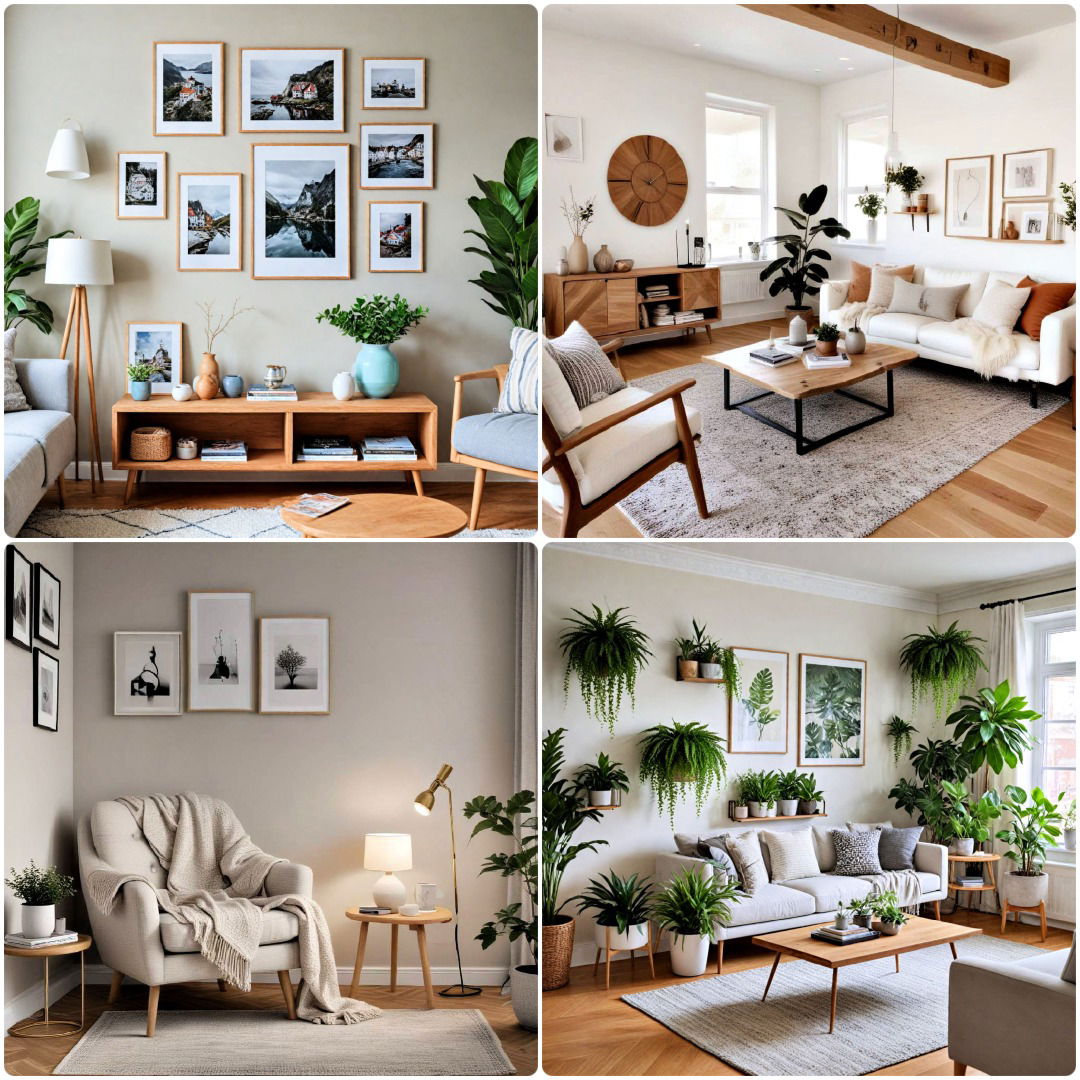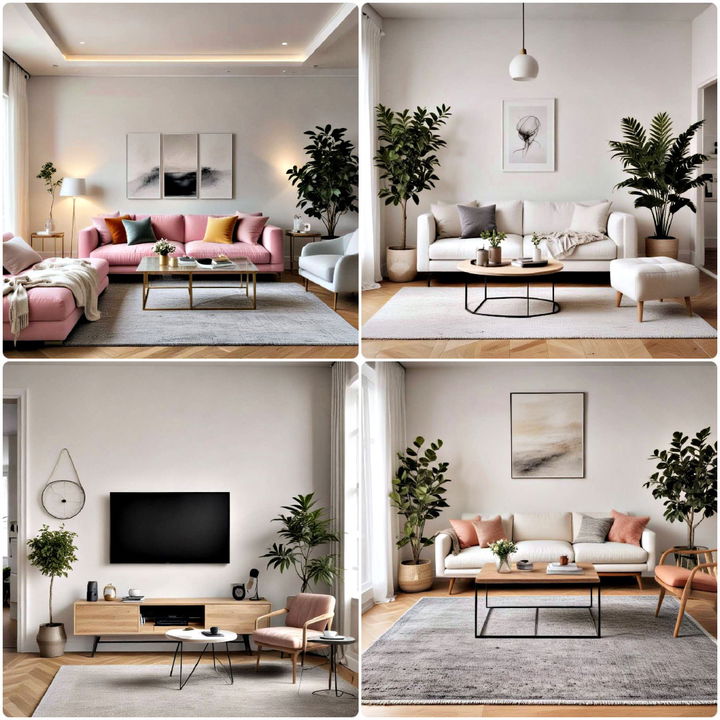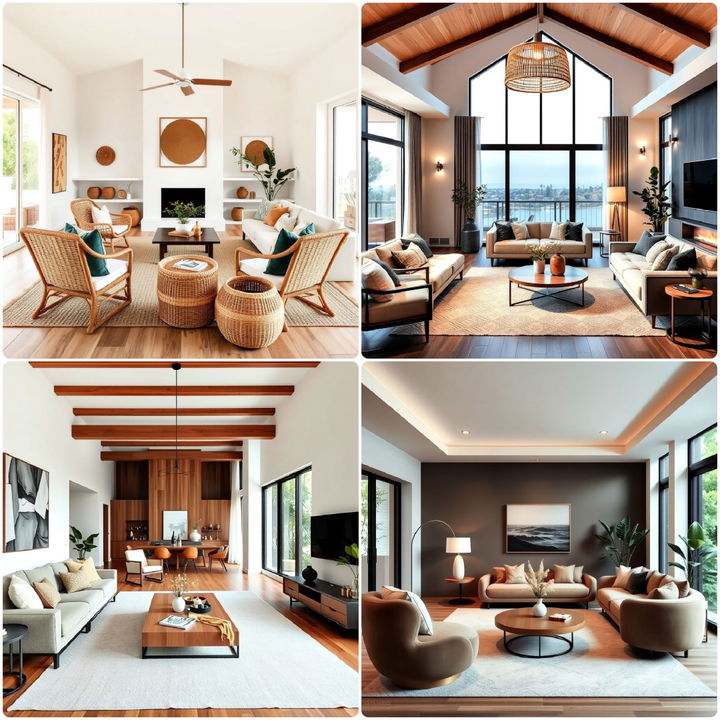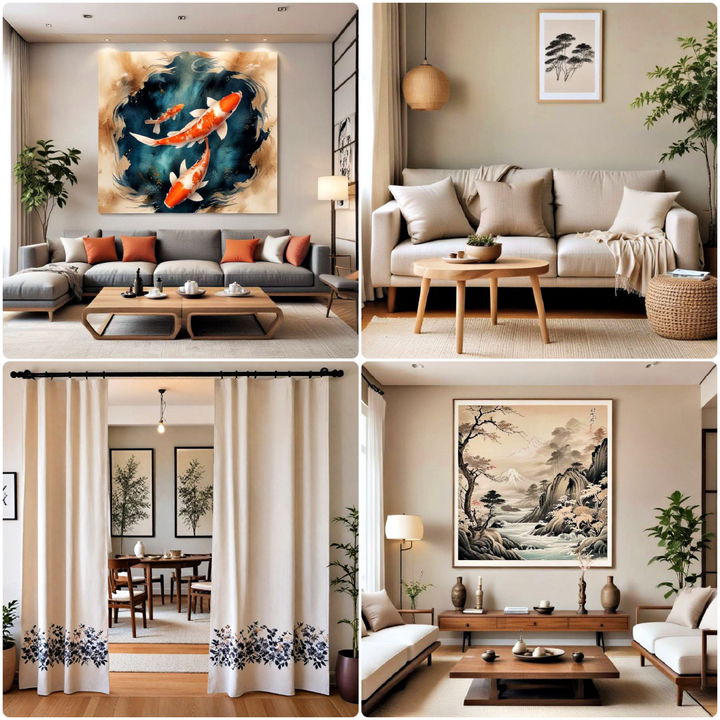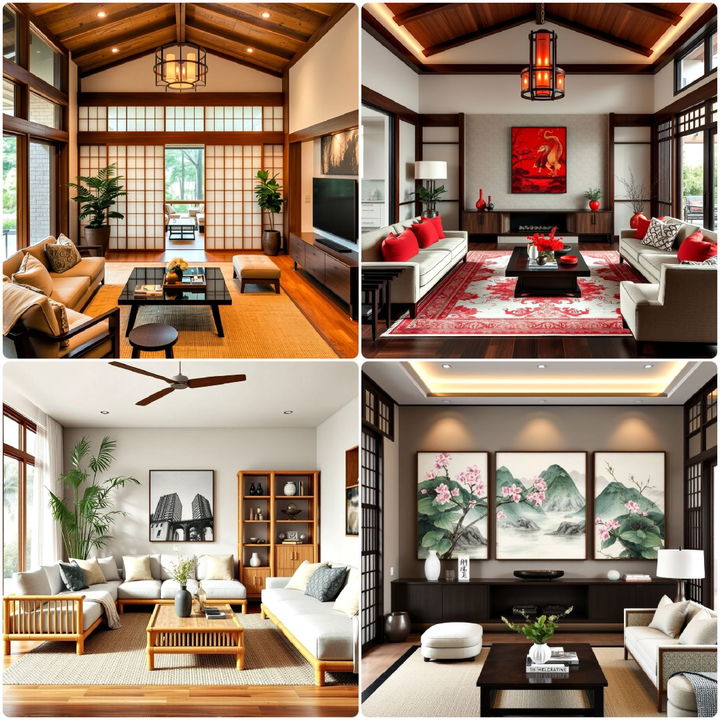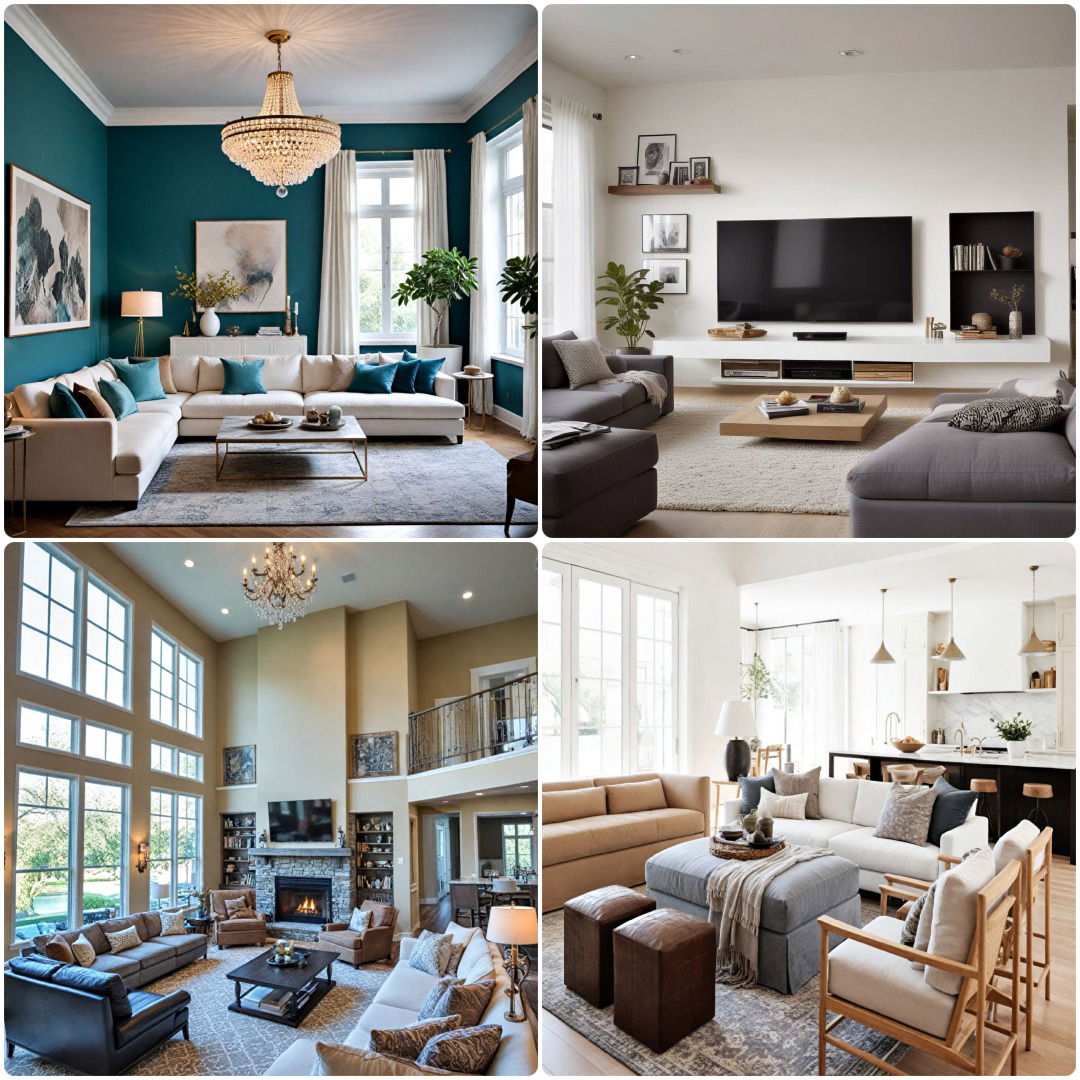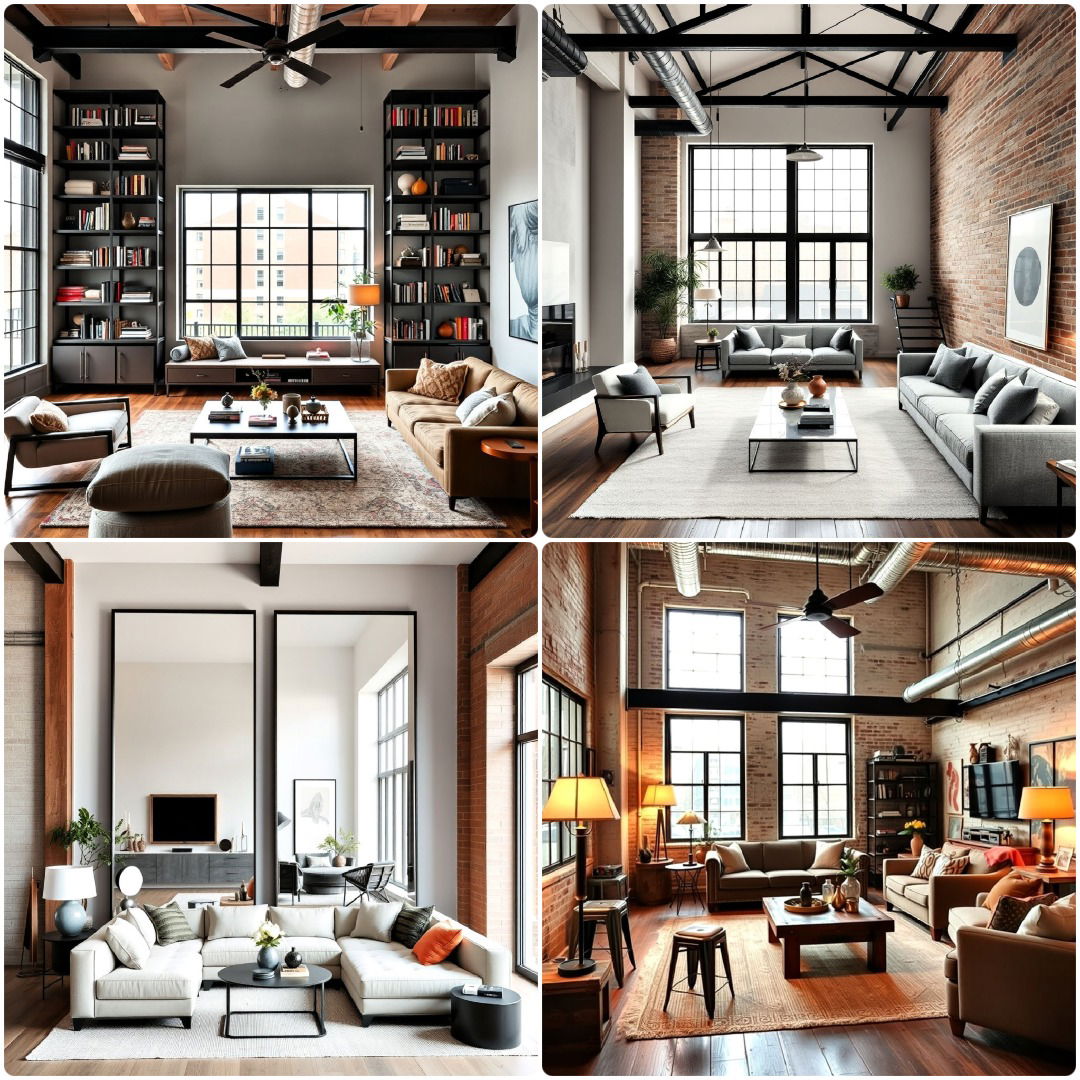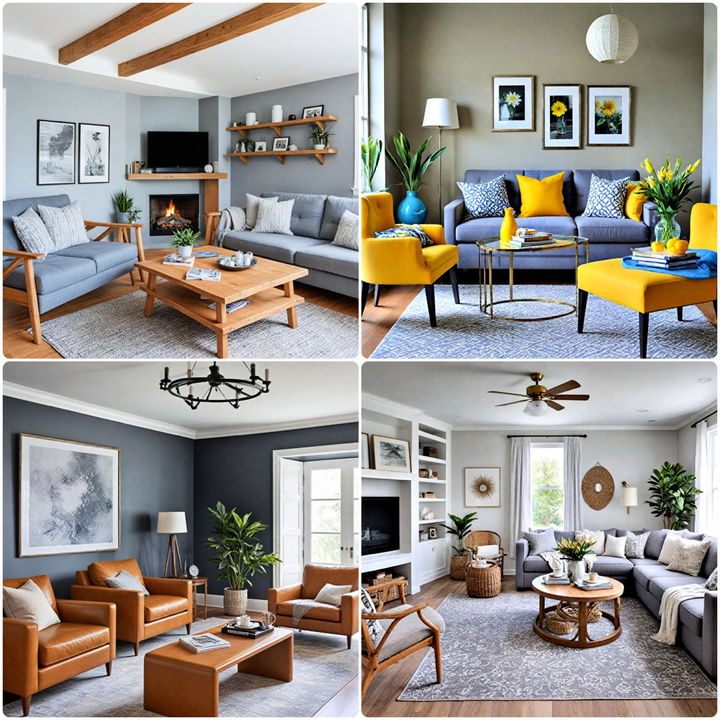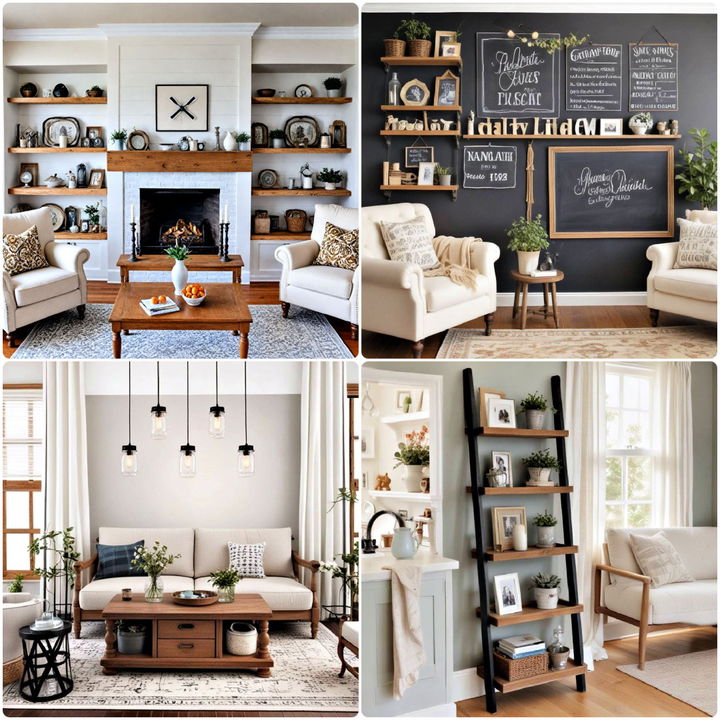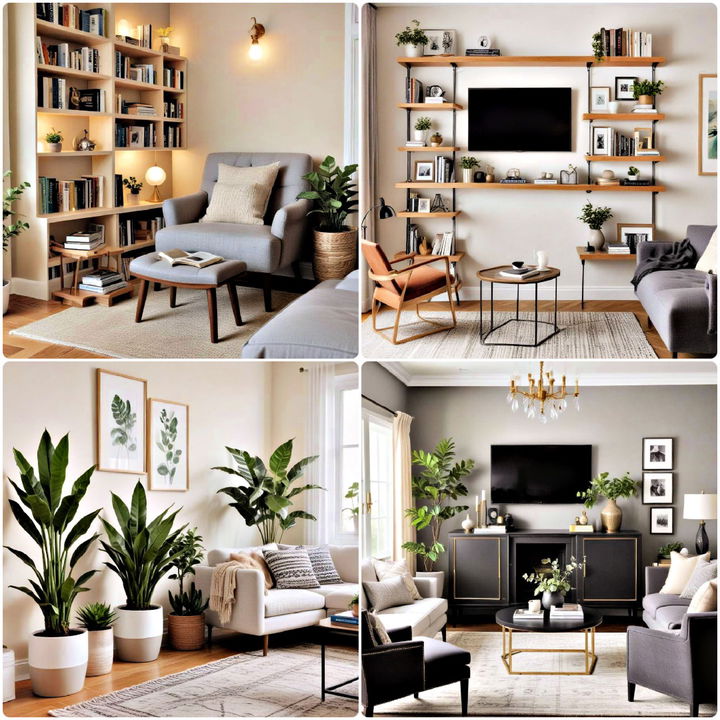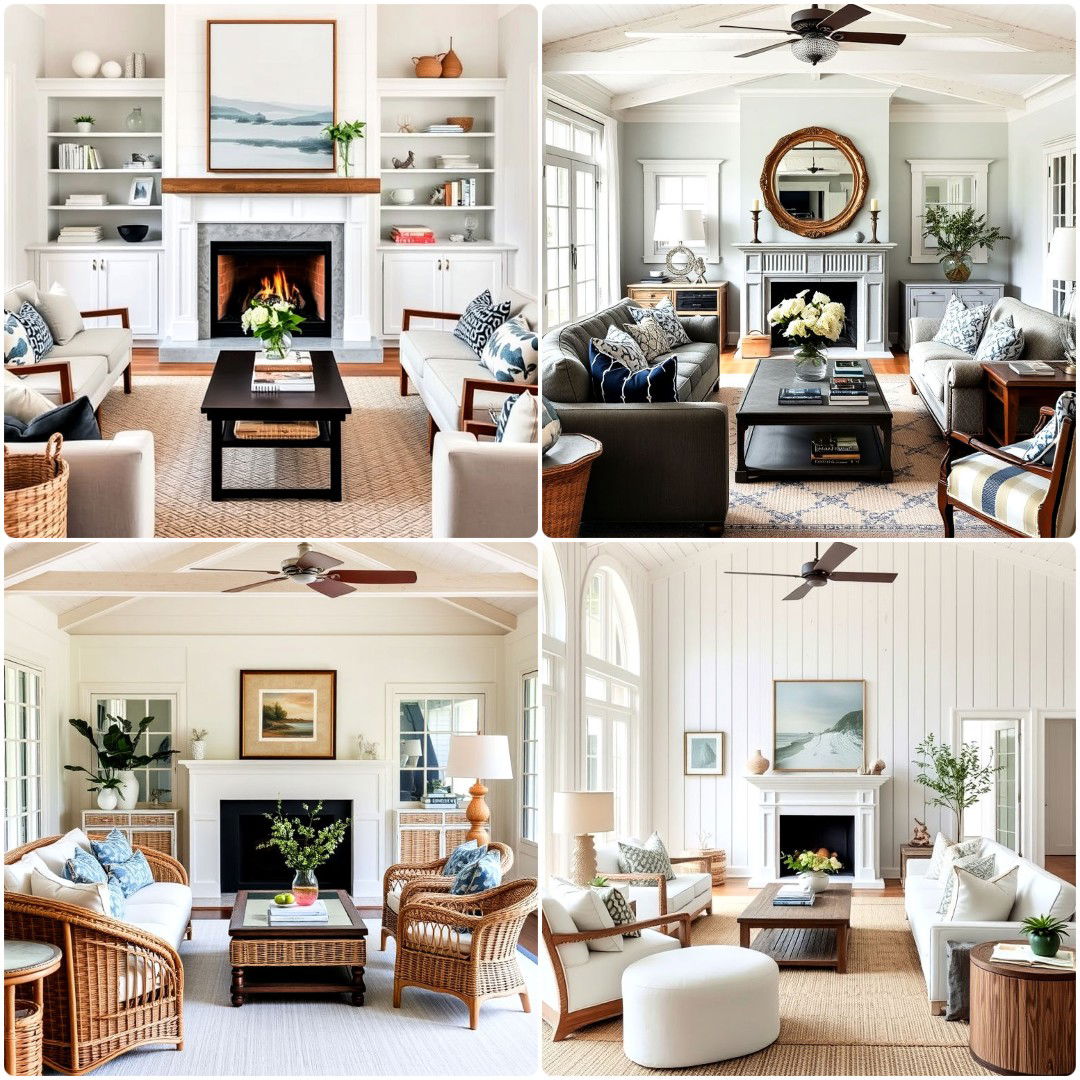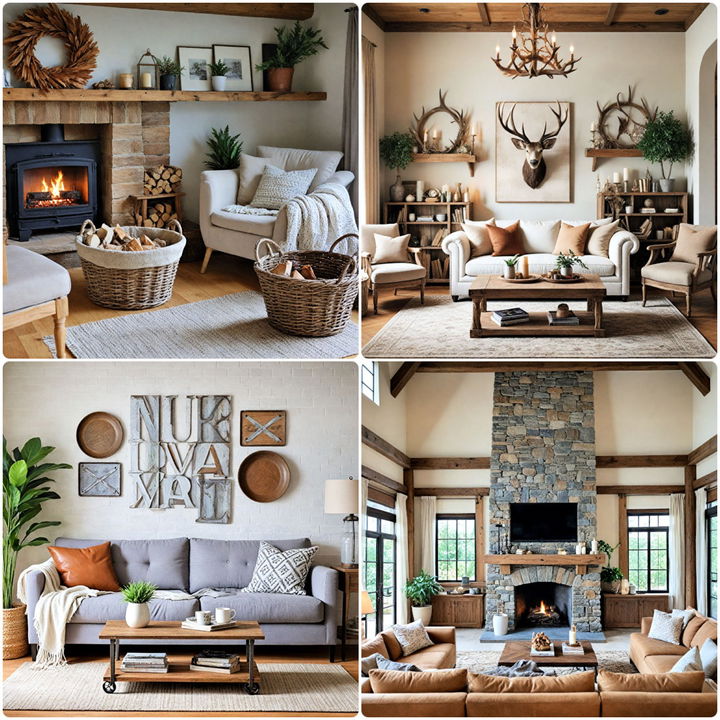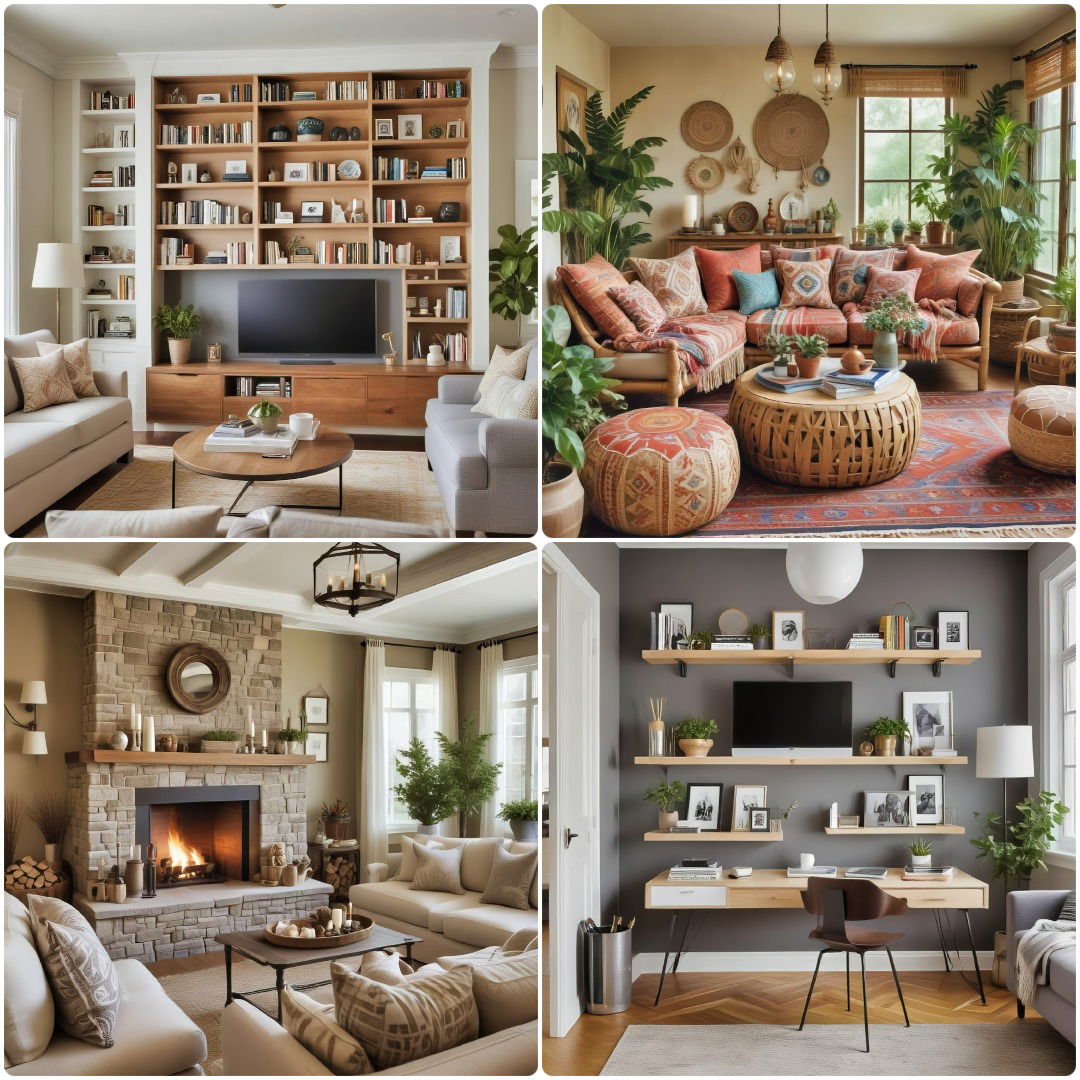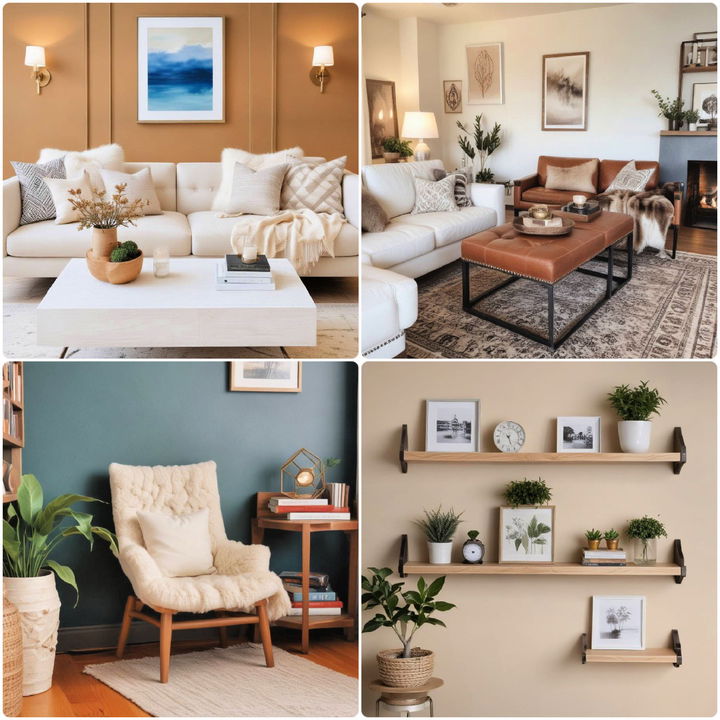Discover the beauty of these Japandi living rooms that blend Japanese minimalism with Scandinavian functionality. This style focuses on simplicity, natural elements, and a clean, clutter-free environment. A Japandi-style living room combines neutral colors and natural light, creating a serene, calming space. The minimalist approach ensures each element and piece of furniture has a purpose.
Inspiring yet practical, a Japandi-style living room integrates wooden textures and green plants to bring nature indoors. The key is balance, maintaining a cozy atmosphere while minimizing excess. Achieving a Japandi living room look involves thoughtful choices in furniture and decor that align with both Zen principles and Scandinavian efficiency.

Discover the elegance of Japandi living rooms, blending Japanese minimalism with Scandinavian functionality for a serene and stylish home.
1. Minimalist Furniture
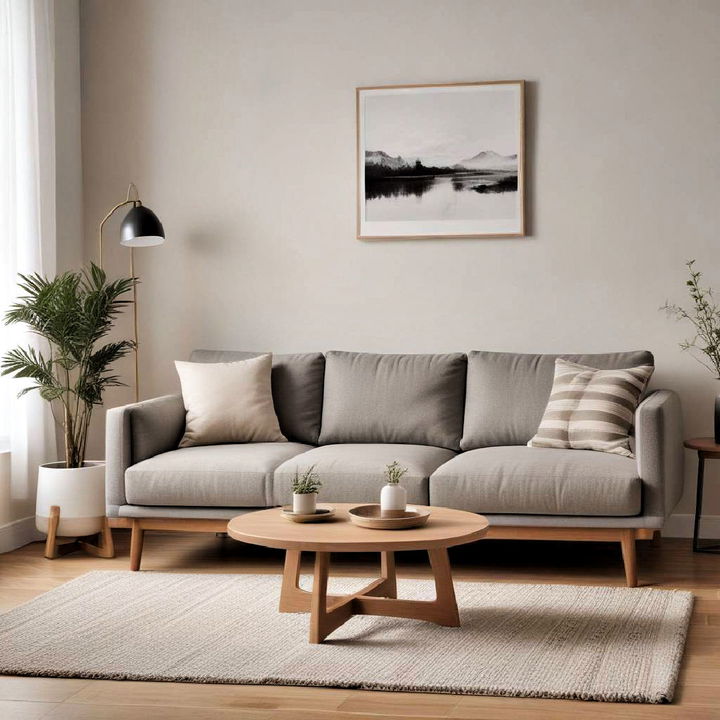
Imagine a sofa that’s both cozy and sleek. Japandi furniture combines Scandinavian simplicity with Japanese elegance. Think clean lines, neutral colors, and sleek designs, all aimed at creating a calming atmosphere. Minimalist furniture doesn't mean discomfort. Rather, every piece has a purpose and seamlessly fits into your living room.
2. Natural Light
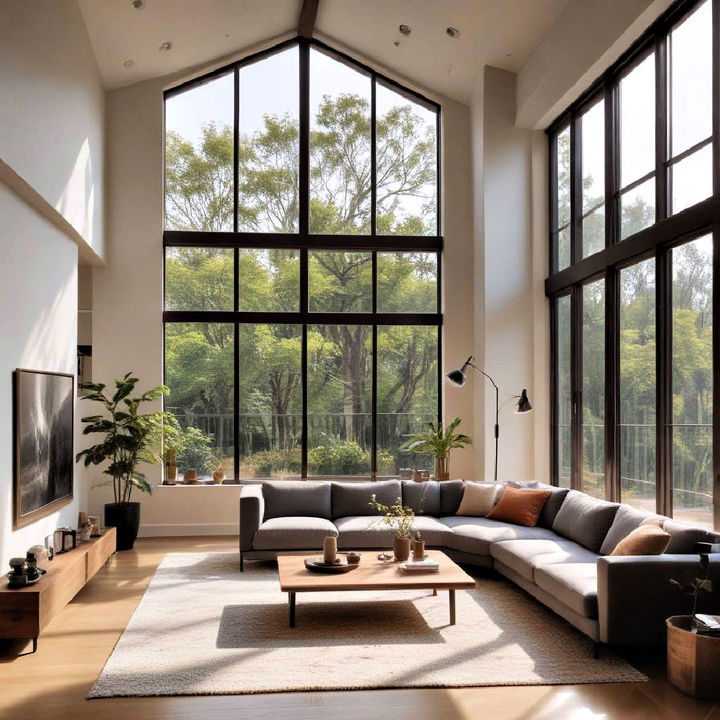
Natural light breathes life into any space. Japandi style emphasizes large windows and open spaces to let the sunlight stream in. Use light curtains to maintain privacy but still allow the sun's warmth. This natural element not only saves energy but also enhances the beauty of the room's natural materials.
3. Neutral Color Palette
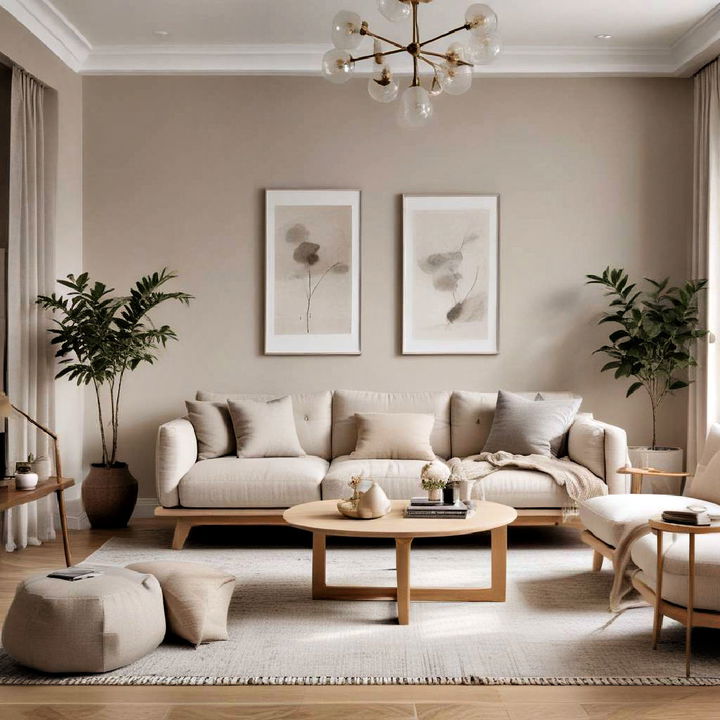
Neutral shades like beige, white, and soft grays play a crucial role in Japandi interiors. These colors create a serene and balanced environment. They make it easier to blend different elements and textures within the room. A neutral palette serves as a clean backdrop for your decor pieces to shine.
4. Functional Storage
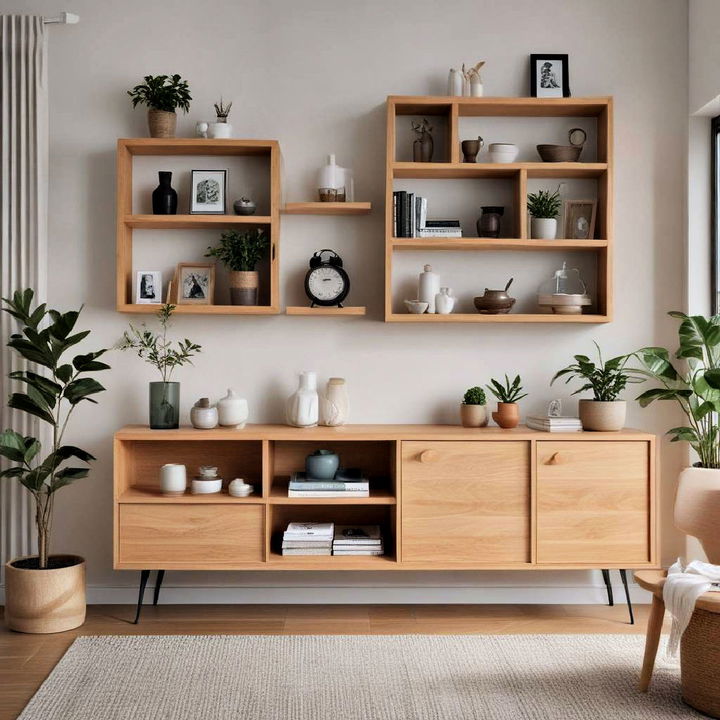
Create a serene japandi living room that merges Scandinavian and Japanese aesthetics. Storage solutions in Japandi design aren't just practical but also aesthetically pleasing. Think sleek cabinets and floating shelves that help keep clutter at bay while adding to the room's overall look. Function meets style here, offering clever ways to organize without disrupting the flow of the room.
5. Organic Materials
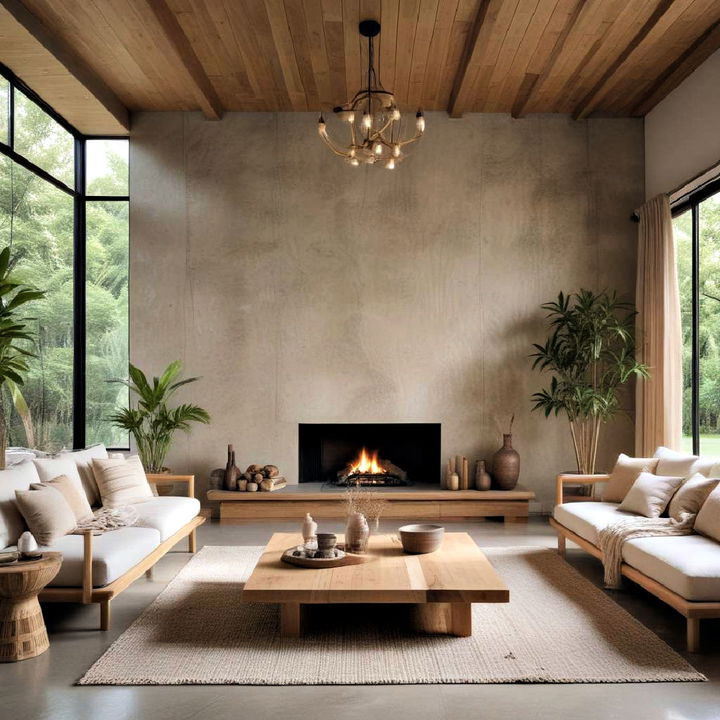
Organic materials like wood, bamboo, and stone are often used in Japandi homes. These materials bring a sense of nature indoors, contributing to a tranquil and earthy environment. They are not only durable but also lend a timeless beauty to your living room.
6. Greenery
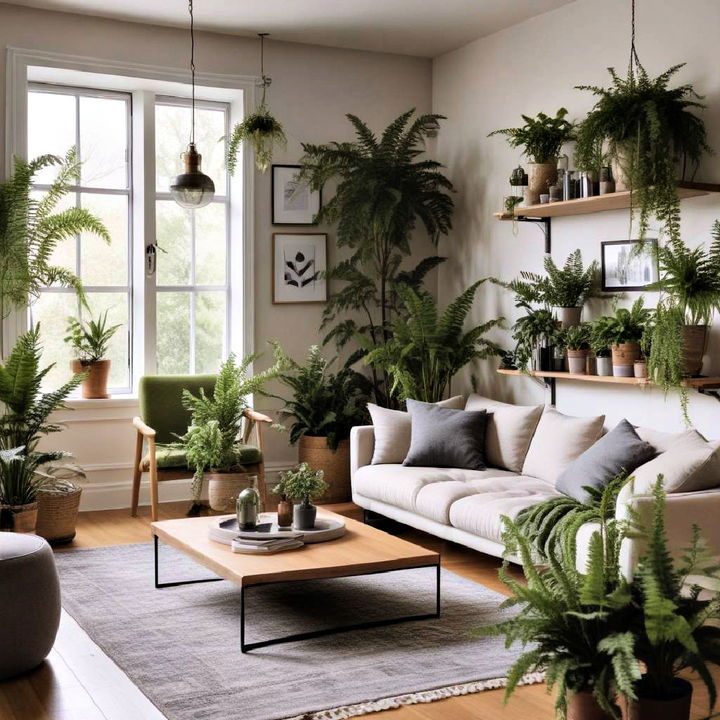
Adding plants can make your Japandi living room come alive. Greenery aligns with the style's focus on natural elements. Choose simple, low-maintenance plants like ferns or succulents. They add a splash of color and a breath of fresh air without overwhelming the space.
7. Simple Artwork
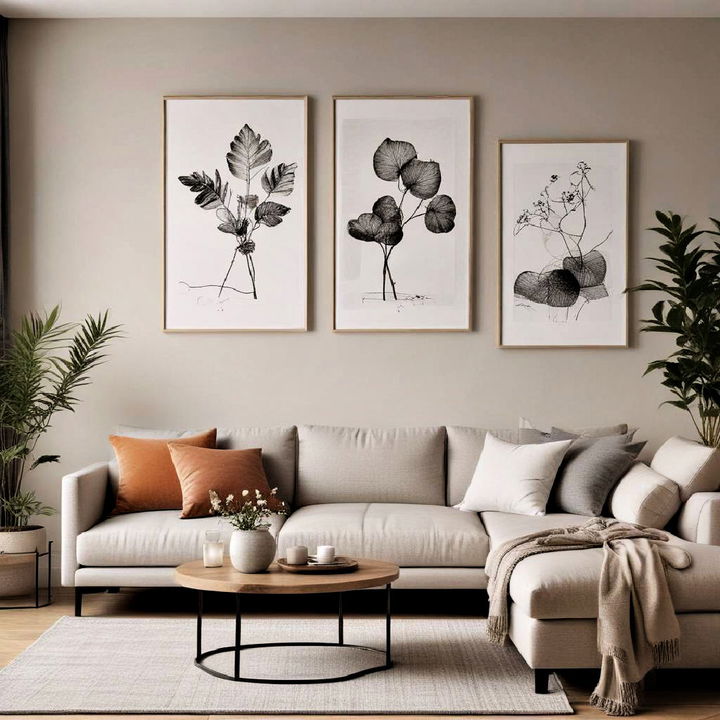
In a Japandi living room, artwork should enhance, not dominate. Opt for simple, minimal pieces like line drawings or abstract art. These artworks complement rather than compete with other design elements, ensuring a cohesive look. The idea is to highlight the space rather than overcrowd it.
8. Cozy Textiles
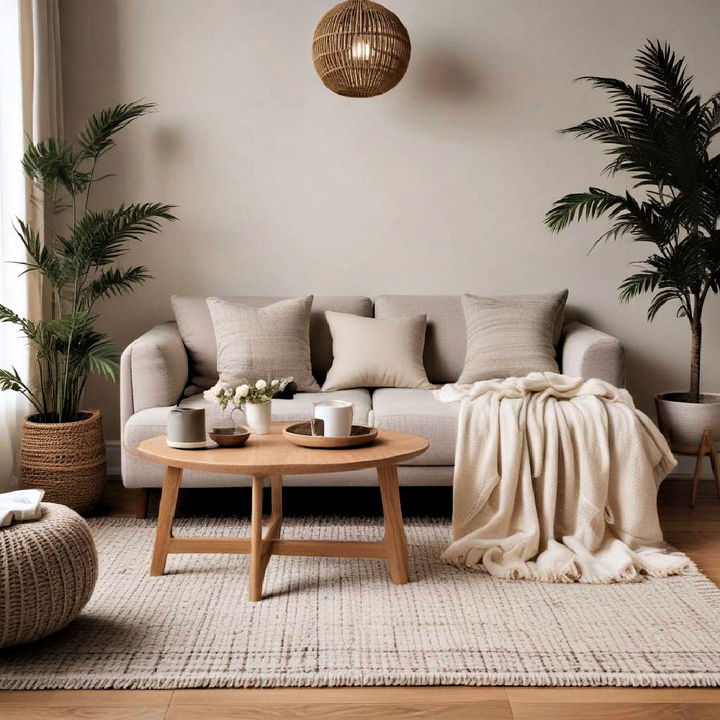
Embrace tranquility in your Japandi-style living room with natural materials and simple lines. Comfort is key in Japandi design, and that’s where textiles come in. Soft rugs, throw pillows, and blankets in neutral shades can add warmth and coziness. Think natural fabrics like cotton, linen, and wool that not only feel good but also look great.
9. Low Furniture
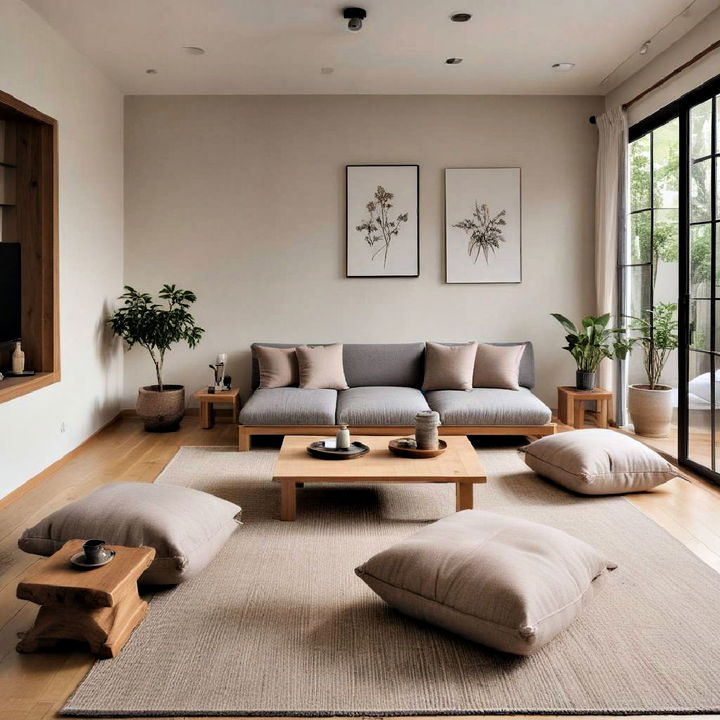
Low furniture is a common trait in Japandi design, inspired by traditional Japanese living. Low-sitting sofas, coffee tables, and floor cushions create an open and inviting space. This design helps in creating a sense of flow and continuity, making your living room feel more spacious and grounded.
10. Open Space
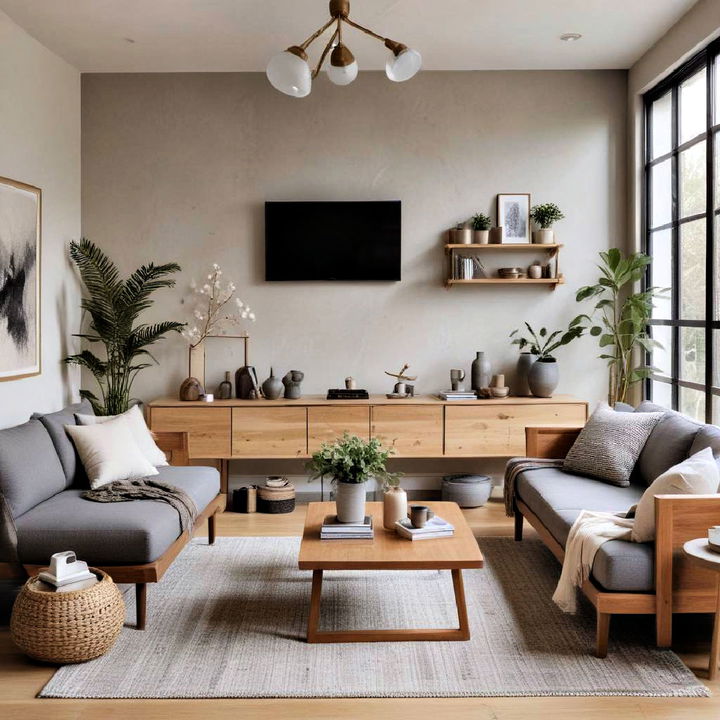
A Japandi living room isn’t overcrowded but well-curated. Open spaces between furniture pieces contribute to a sense of tranquility and order. This openness aligns with the minimalist ethos, providing a clear, uninterrupted flow that enhances relaxation and peace.
11. Tatami Mats
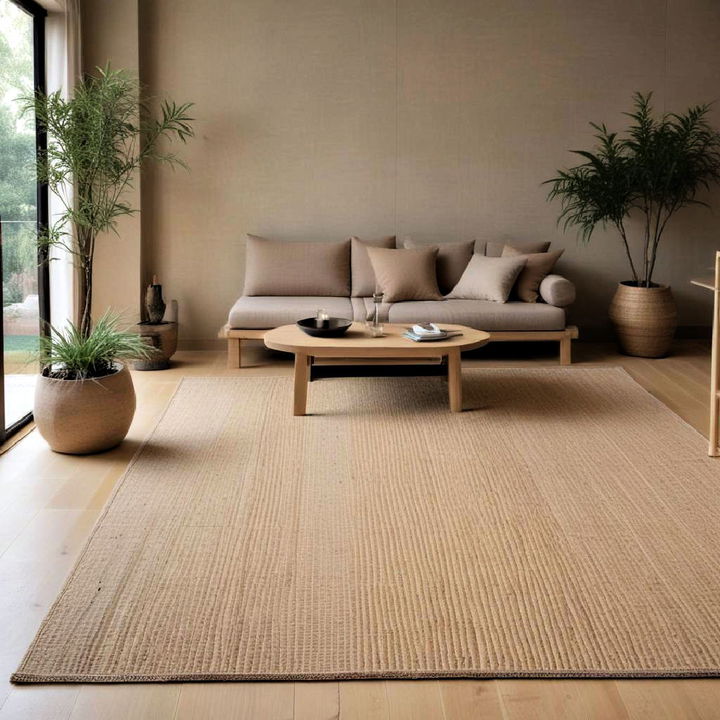
Tatami mats are a nod to traditional Japanese interiors and add an authentic touch to a Japandi living room. They are made from natural rush grass and provide a textured, earthy feel underfoot. These mats are both functional and aesthetic, offering a unique flooring option that enhances the room's overall design.
12. Warm Lighting
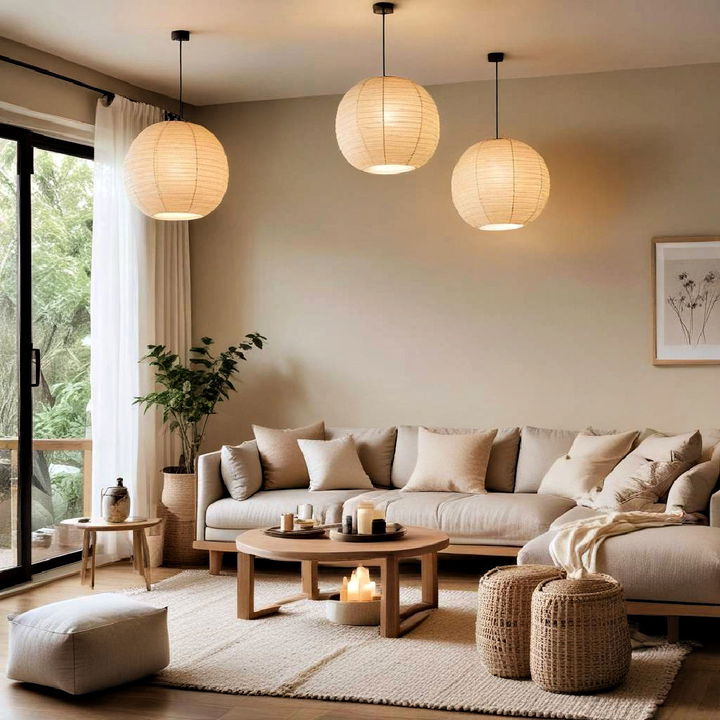
Warm lighting is key in creating a cozy atmosphere. Opt for soft, diffused lights rather than harsh, bright ones. Paper lanterns or wooden lamps with warm LED bulbs can create a gentle, inviting glow. This type of lighting complements the natural materials and neutral tones prominent in Japandi style.
13. Sliding Doors
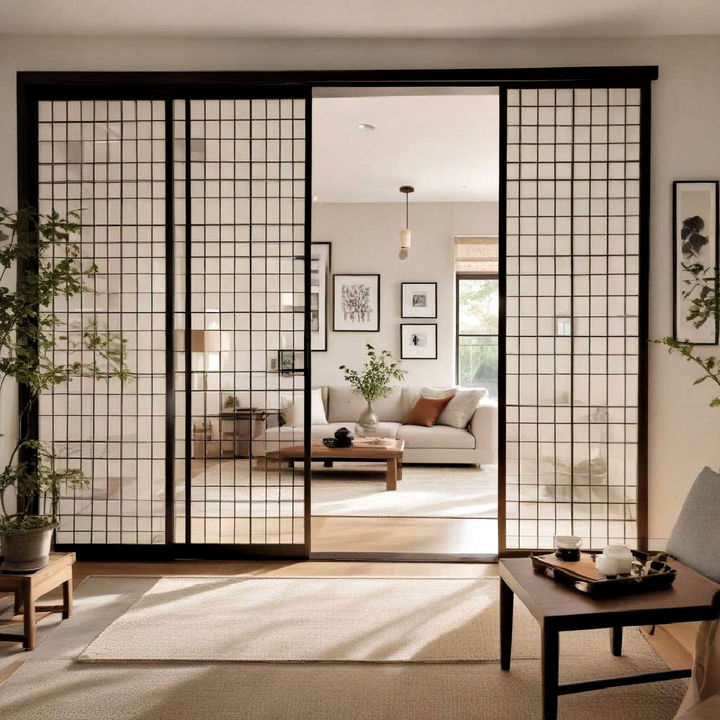
Sliding doors, or shoji screens, can add a touch of practicality and elegance to your living room. These doors save space and provide a subtle, sophisticated way to separate areas. Made from wood and paper, they add a lightweight yet structured element that enhances the room's flow.
14. Textured Walls
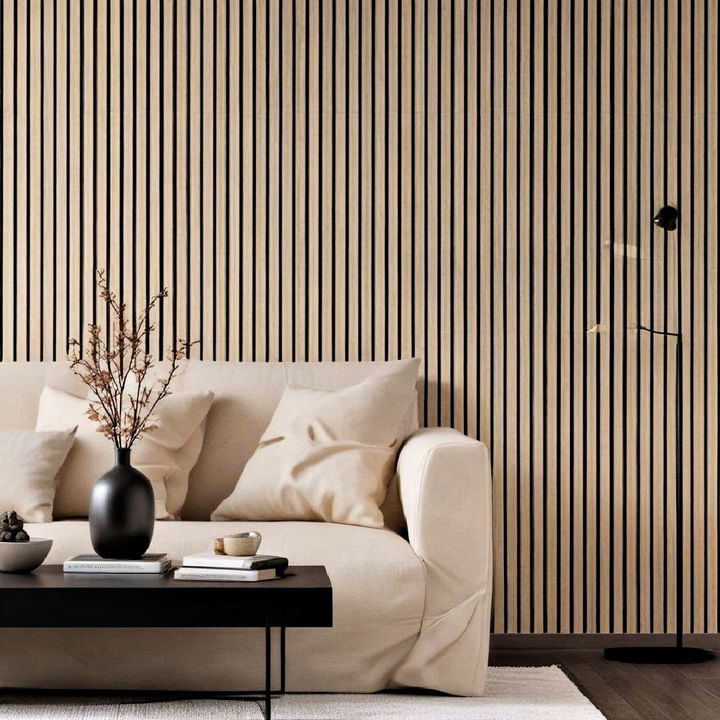
Textured walls can add depth and interest to your Japandi living room. Consider using materials like wood panels, natural stone, or even textured wallpapers. These elements add a tactile quality that makes the space more engaging without overwhelming the primary minimalist focus.
15. Handmade Decor
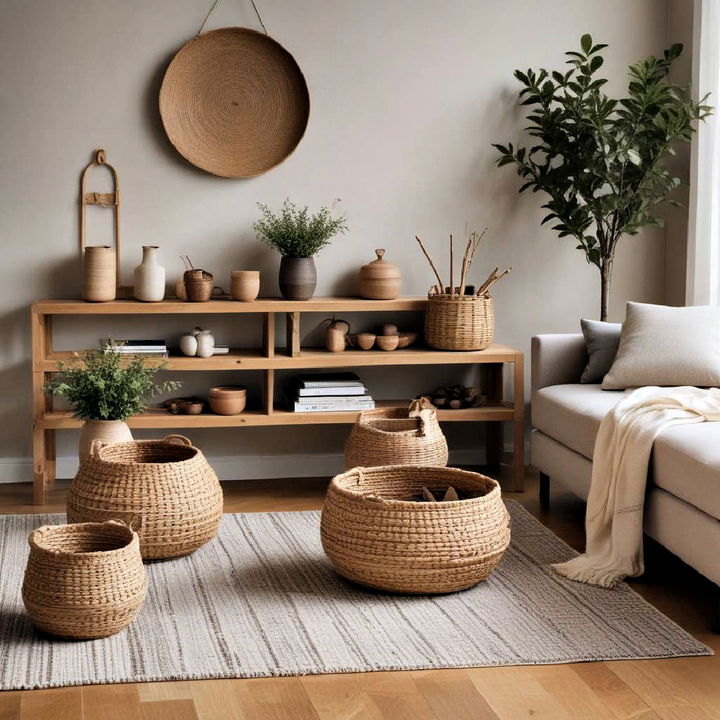
Transform your space with a minimalist lifestyle Japandi living room approach for a clutter-free home. Handmade decor items like pottery, woven baskets, and artisanal crafts lend a personal touch to your living room. These pieces emphasize the Japandi philosophy of valuing craftsmanship and authenticity. They add both character and individuality to the space, making it uniquely yours.
16. Low-profile Plants
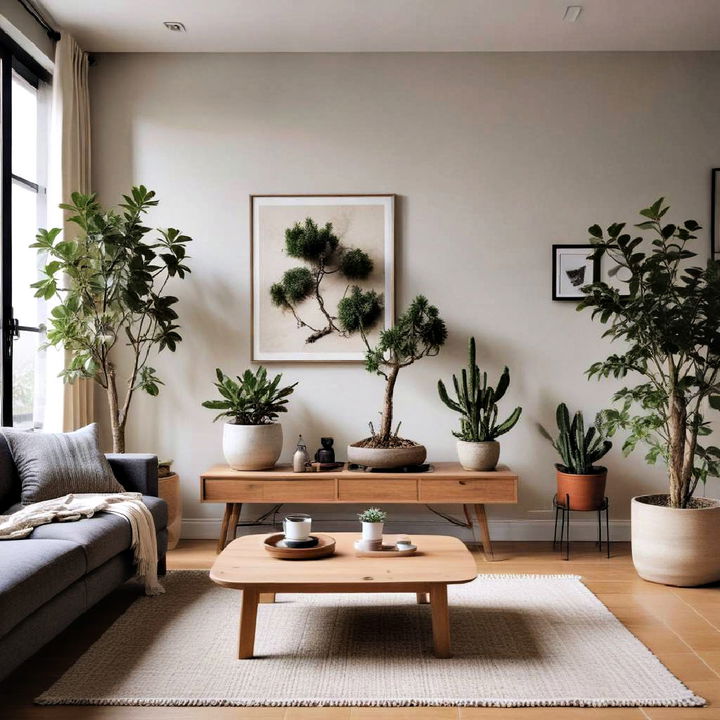
Low-profile plants like bonsai or small cacti perfectly fit the Japandi aesthetic. These plants are easy to maintain and don’t overtake the room. They add a subtle touch of greenery, promoting a connection to nature while still respecting the clean lines and simplicity of the design.
17. Floor Seating
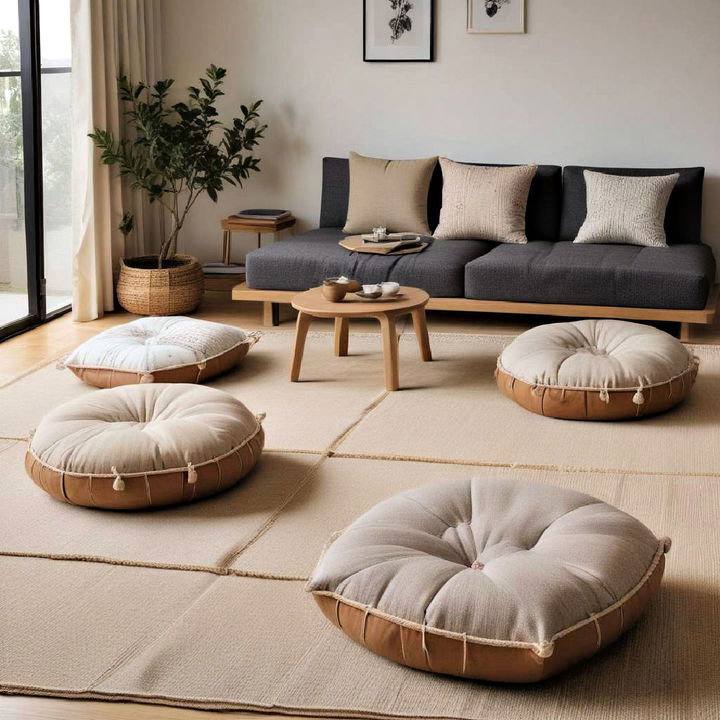
Floor seating, such as zabuton cushions or low stools, adds a cultural layer to your Japandi living room. This seating option promotes relaxation and a more intimate gathering space. It ties back to Japanese traditions while fitting seamlessly into the minimalist, Scandinavian-inspired setting.
18. Balanced Symmetry
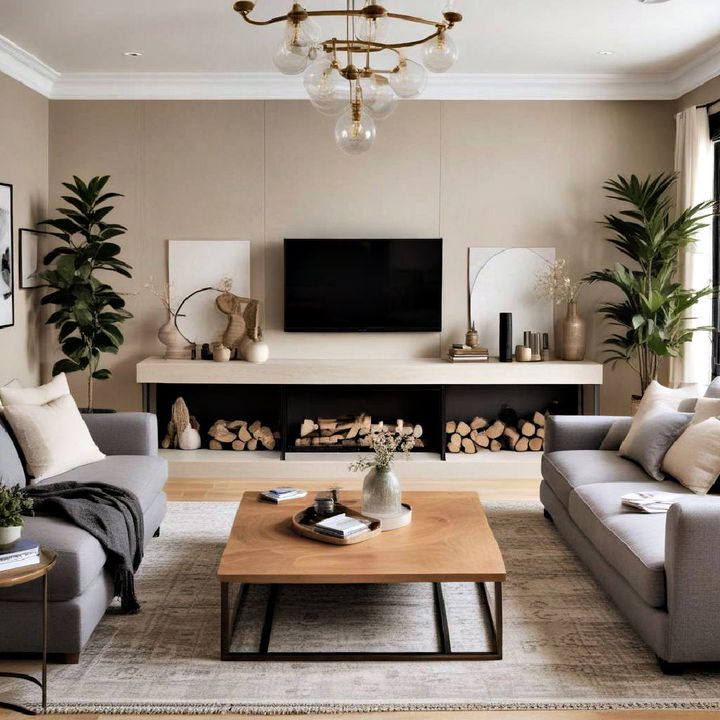
Symmetry can create a balanced and harmonious look in your Japandi living room. Arrange furniture and decor elements in a symmetrical manner to promote visual order and tranquility. This approach is soothing to the eye and reinforces the calm ambiance inherent in Japandi style.
19. Subtle Patterns
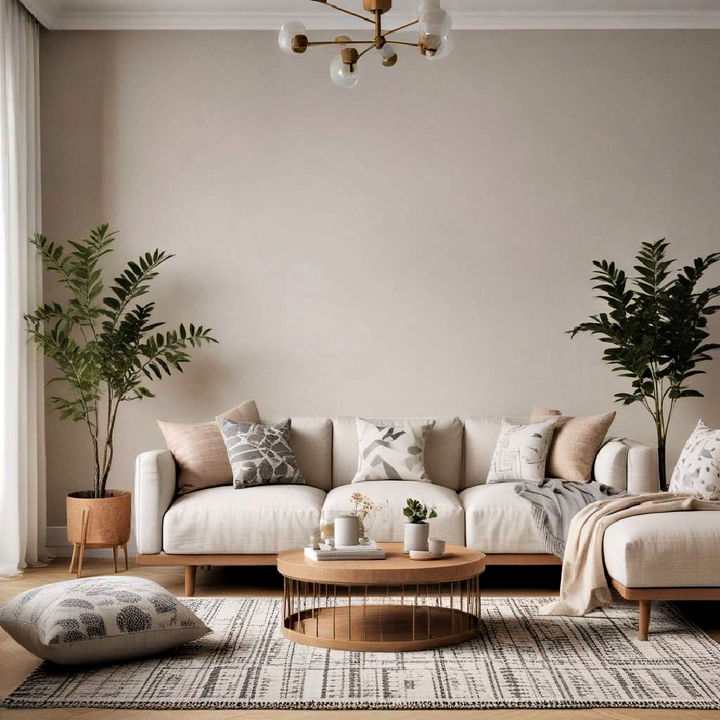
While minimalism is key, subtle patterns can add a layer of intrigue. Think of delicate geometric designs or minimal floral prints that don’t overpower the space. These patterns can be incorporated through textiles, rugs, or even small artwork, providing a balanced touch of sophistication.
20. Personal Touches
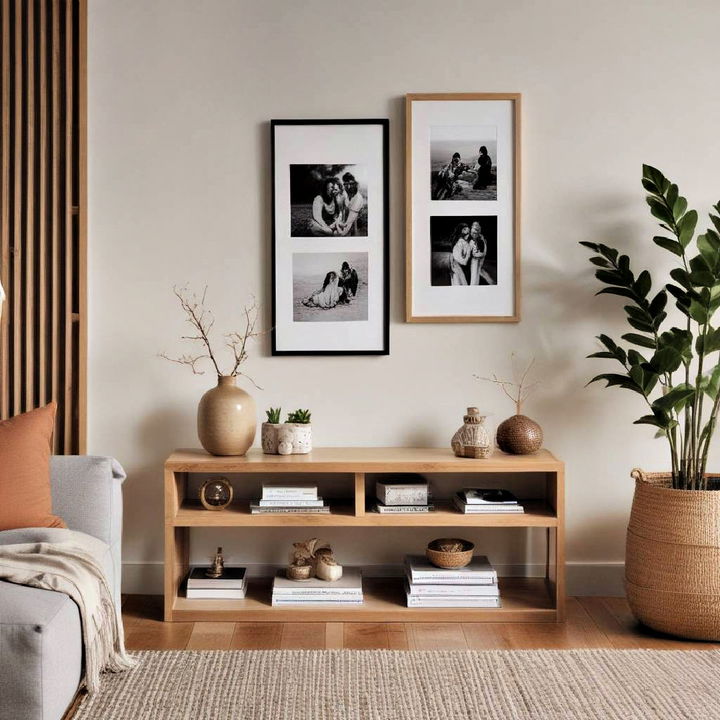
Discover inspiring japandi living room ideas to bring minimalist elegance to your home. Lastly, incorporate personal touches to make the space truly your own. Family photos, mementos, or even travel souvenirs placed tastefully can epitomize the Japandi principle of meaningful possessions. These items reflect your personality and ensure the living room is not just stylish, but also a genuine representation of you.
21. Low Bookshelves
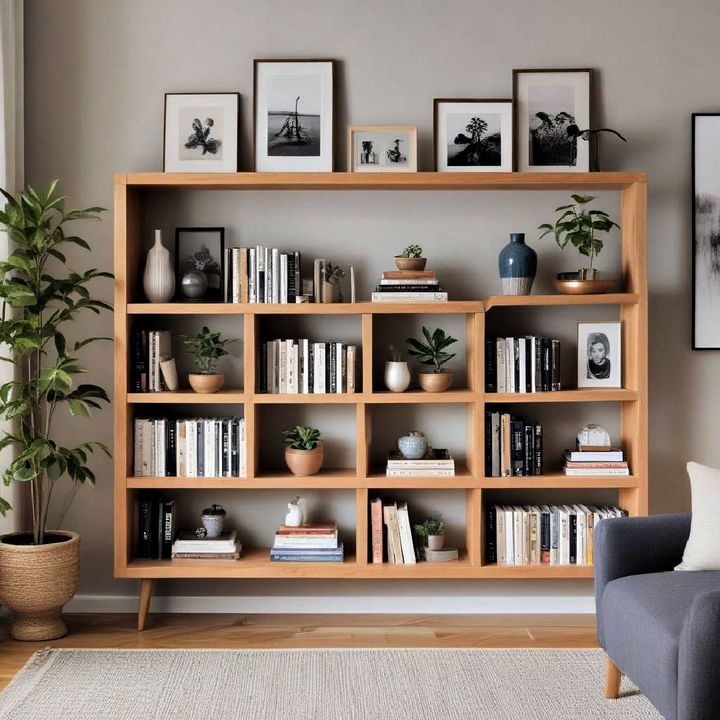
Low bookshelves can be both functional and stylish in a Japandi living room. They keep things tidy while displaying your favorite books and decor items. Their low profile helps maintain the open, airy feel of the space, while the natural materials blend effortlessly with your aesthetic.
22. In-built Shelving
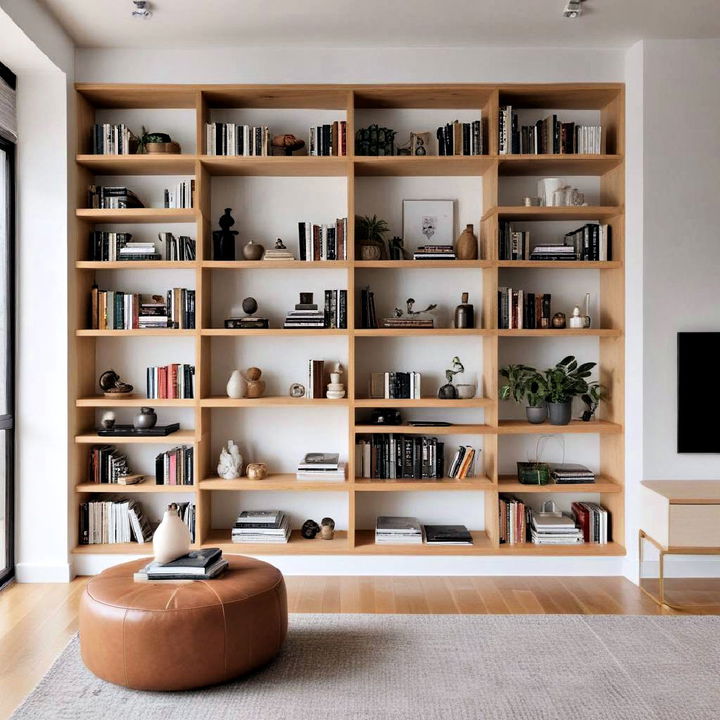
In-built shelving creates a seamless look, integrating storage directly into the architecture of the room. These shelves offer plenty of space for books, decor, and essentials without requiring additional furniture. Customizable and sleek, they maintain the clean lines essential to Japandi design.
23. Matte Finishes
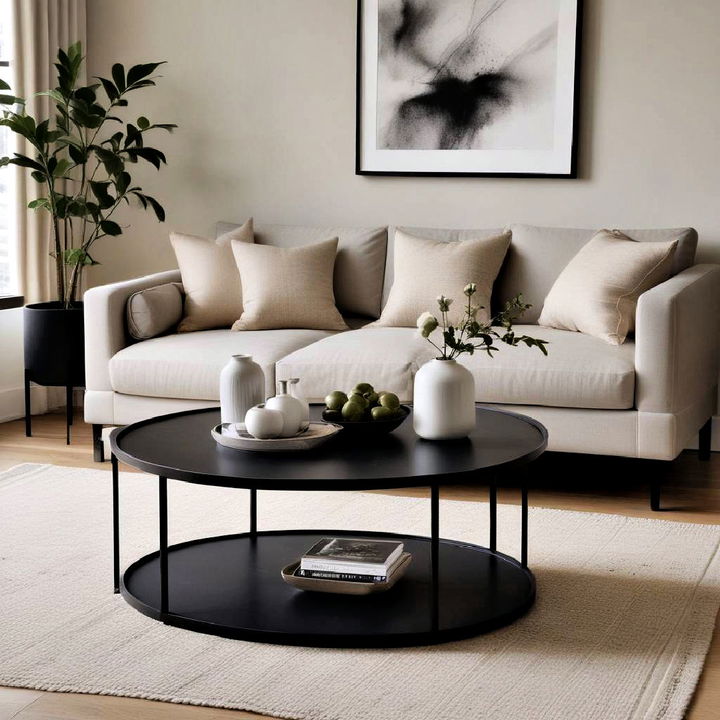
Matte finishes provide a sophisticated and understated look. Whether it’s a matte black coffee table or a matte white vase, these surfaces avoid the glare and shine of glossy finishes, contributing to a more subdued atmosphere. They add a touch of elegance while staying true to the understated nature of Japandi design.
24. Clutter-Free Surfaces
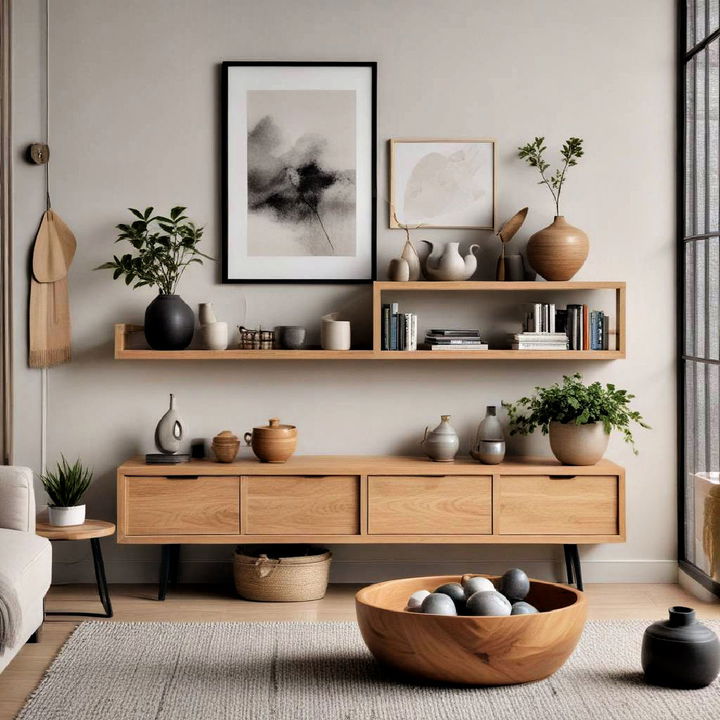
Keeping surfaces clutter-free is crucial in Japandi design. Opt for closed storage solutions or decorative bowls to conceal everyday items. This practice enhances the room's calm, organized feel, allowing you to focus on the beauty and functionality of your essential pieces.
25. Soft Rugs
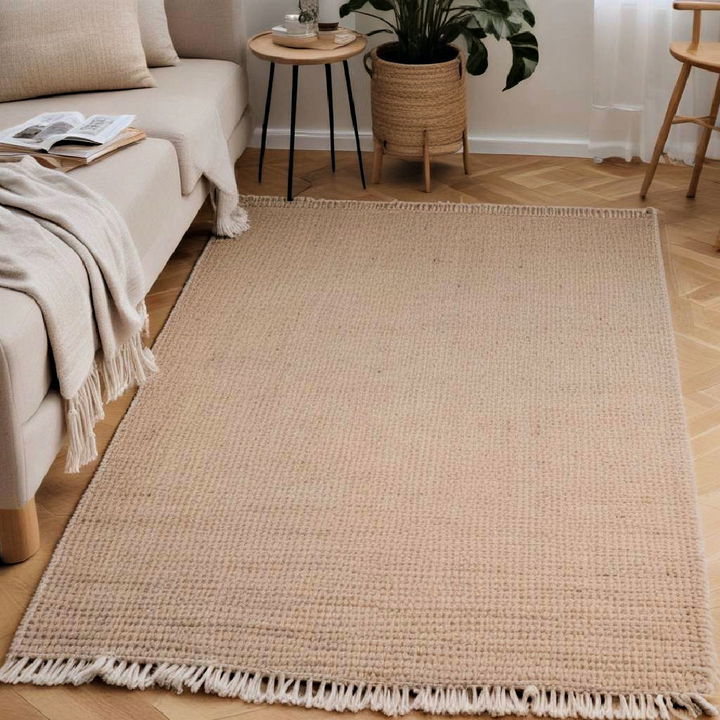
Optimize space in a small Japandi living room with functional and stylish decor. Soft rugs underfoot add an element of comfort and warmth to your living space. Choose simple, natural fiber rugs in neutral tones to complement your other decor. These rugs provide a soft landing for your feet and enhance the overall cozy, inviting atmosphere of the room.
26. Art Display Ledges
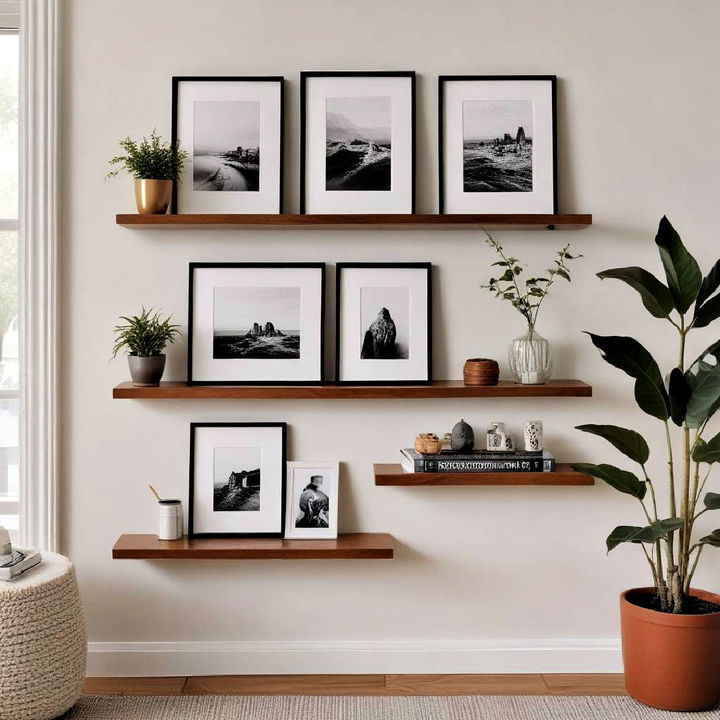
Art display ledges offer a simple way to showcase your favorite pieces without committing to permanent holes in the wall. These narrow shelves let you easily change out art or photos, keeping the space dynamic and fresh. They fit perfectly with the flexible and minimalist principles of Japandi design.
27. Exposed Wooden Beams
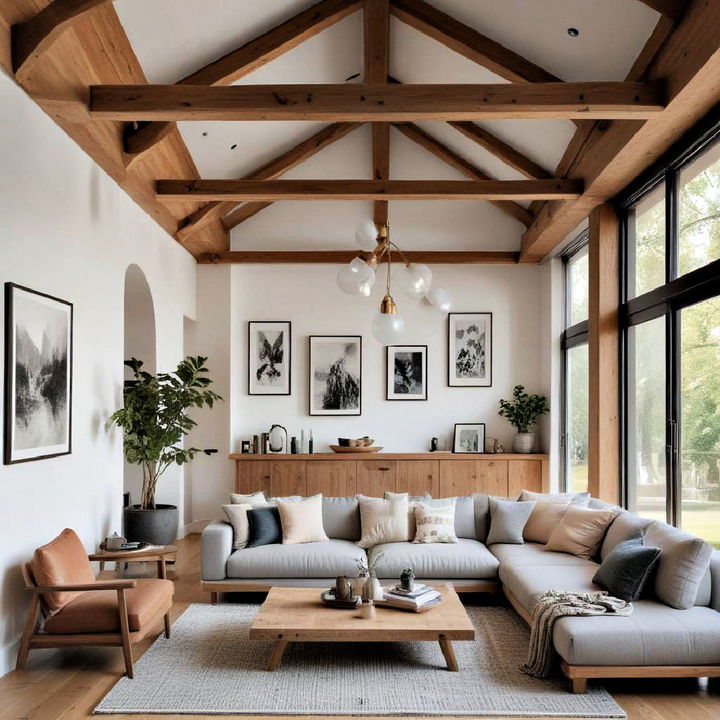
Exposed wooden beams bring an architectural interest to your living room. They emphasize the natural materials core to Japandi style while adding a rustic touch. These beams create a visually striking contrast against crisp, clean walls, providing warmth and character to the room.
28. Subtle Contrasts
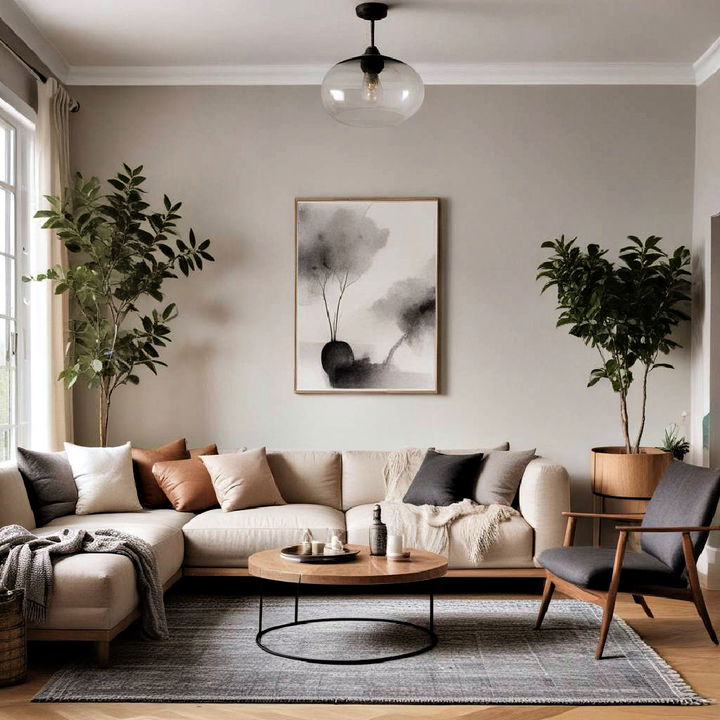
Introducing subtle contrasts like pairing light and dark woods or mixing different textures can add depth without overwhelming the space. This balance keeps the room visually interesting while maintaining the serene, cohesive look central to Japandi aesthetics.
29. Ceramic Pieces
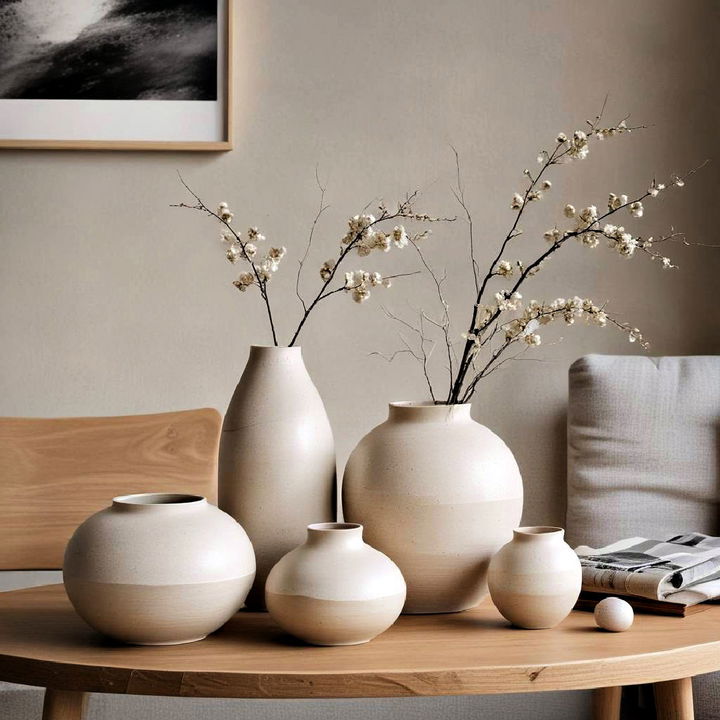
Enhance your home with a thoughtful japandi living room design that balances beauty and function. Incorporate ceramic pieces such as vases, bowls, or sculpture to add an artistic element to your living room. Handmade ceramics often feature organic shapes and subtle textures that harmonize with the natural themes of Japandi design. These pieces can serve as beautiful focal points.
30. Solid Wood Coffee Table
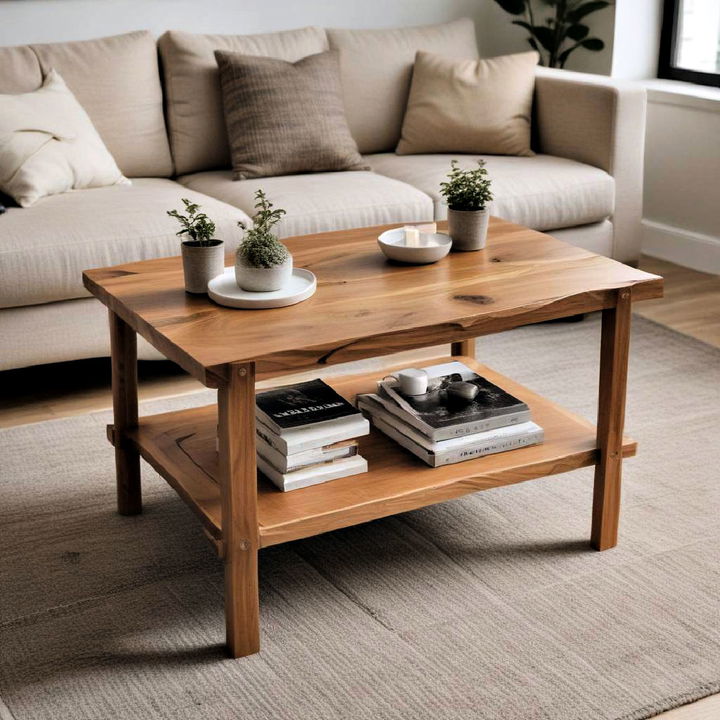
A solid wood coffee table can be both a centerpiece and a functional element in your living room. Choose a design with clean lines and minimal details. The natural grain and texture of the wooden surface add warmth and authenticity, anchoring the space in timeless elegance.
Conclusion:
In conclusion, incorporating these japandi living room designs can transform your space into a serene, minimalist haven. Focus on clean lines, neutral tones, and natural materials to achieve that perfect zen ambiance. With these 30 japandi living room ideas, you can create a calming, clutter-free environment that offers both functionality and aesthetic appeal. Implement these tips to enjoy a tranquil, harmonious space every day.




